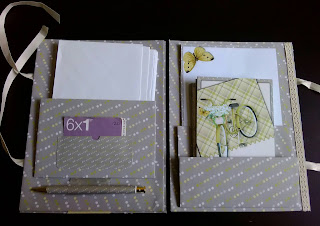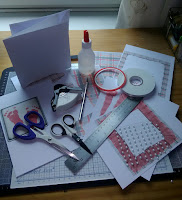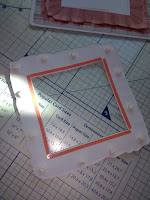As usual we will start with an overview of the things that you will need to hand - which are

Cutting mat
Cutting blade & Ruler
Ball tool
Scoring tool
Small bladed scissors
Red Tape
Repositionable glue
Tacky glue
Clear glitter glue
Selection of ribbons
Ivory pearls
Natural effect buttons
Book of Postage stamps
Pen - I used one from my local pound shop that cost around 50p as long as you can take it apart and put it back together try to also get one that has a vertical stripe or repeating pattern on the barrel.
Prepared and printed A4 background papers x5
Prepared and printed A5 writing paper and A6 note cards (I will talk about these later)
Prepared and printed sheet with strip of complementary paper flower embellishments and journaling cards
A4 sheet of acetate
3x A4 sheets of heavy weight Kraft card
 Just a quick note about the actual stationary. It was all printed from Jodi's kit. I used magazine weight printer paper from the Tattered lace range as this takes ink well and is a nice surface to write on for the notepaper and 250gsm smooth inkjet card for the notelets. You could just print A6 size fronts for the notelets and stick them onto card blanks if you wanted to but I chose to make my own. If anyone wants any help with doing this please feel free to get in touch. The envelopes were just plain white ones from my stash but again you can make your own if you are so inclined.
Just a quick note about the actual stationary. It was all printed from Jodi's kit. I used magazine weight printer paper from the Tattered lace range as this takes ink well and is a nice surface to write on for the notepaper and 250gsm smooth inkjet card for the notelets. You could just print A6 size fronts for the notelets and stick them onto card blanks if you wanted to but I chose to make my own. If anyone wants any help with doing this please feel free to get in touch. The envelopes were just plain white ones from my stash but again you can make your own if you are so inclined.Start off by taking your pen and dismantling it then you will need to measure down the length of the barrel as accurately as you can and cut a length of your backing paper to match and as wide as you need to wrap all the way around it with an extra 1/4" ( 1/2cm) aprox. to stick it down.
 Run a length of strong red lined tape as near to the long edge as you can. Line this up down one of the stripes - or in my case repeated chevrons - so it is exactly vertical and firmly stick it down. Coat the rest of the paper in strong tacky glue and roll it firmly around the barrel holding it in place for a minute or so to let it grip. Re assemble the rest of the pen and put it to one side to dry completely.
Run a length of strong red lined tape as near to the long edge as you can. Line this up down one of the stripes - or in my case repeated chevrons - so it is exactly vertical and firmly stick it down. Coat the rest of the paper in strong tacky glue and roll it firmly around the barrel holding it in place for a minute or so to let it grip. Re assemble the rest of the pen and put it to one side to dry completely.Take your sheets of Kraft card and cut each one down to make your front and back cover. I found that the width of a steel ruler removed from one long edge and one from the top and one from the bottom was perfect (told you I don't measure unless I absolutely have to!) Use repositionable glue and stick each one down to a sheet of backing paper leave to dry.



Cut around it leaving a 1" edge all around. Fold the edges up to mark the corners snip out the corners at an angle of slightly larger than 90' run a length of red lined tape down each edge fold over and stick neatly. You now have the front and back covered inside ready to add the stationary pockets.
Take your third sheet of Kraft card and cut two pieces that measure 6"x4" (15cm x 10cm) and one 6"x2.5" (15cm x 6cm) using the same method as above cover these with your backing paper. You could just stick these into place on the front and back as they are but I have found that doing it this way makes it difficult to slide your actual stationary in so we are going to make acetate 'hinges' so that the pockets stand proud and give us the room needed. You need to cut strips of acetate as follows
2 x 6"x2" - score these longways down the middle
2 x 1cm x 5cm - score these short ways at 2cm and 3cm
1 x 1cm x 4.5cm - score this short ways at 2cm and 2.5cm
(I am sorry about the interchanging of inches and cm but this is how the measurements work out without having to go into using quarters and eighths etc which I thought would be even more confusing!) I won't add a picture here as acetate is neither easy nor interesting to photograph!
Take one of the larger pockets and the smaller one and one of the 6"x2" strips of acetate and using strong liner tape throughout this section. Making sure you have everything with the right sides facing and any pattern in the right direction stick the strip of acetate to the back of the small pocket lining the long edge up exactly to the front of the folded edge of the acetate, stick the large pocket with the long edge pushed snuggly down into the inner fold of the acetate so you should now have a hinge 'sandwich' that goes, with all the patterns front facing and in the right direction, small pocket, acetate, large pocket, acetate.

Take two of the 5cm strips and the two 4.5cm ones as these are going to hold our pockets proud from the back of the wallet. Run tape along the 2cm sections so you should now have two strips that go 2cm taped 1cm no tape 2cm taped and two strips that go 2cm taped 0.5cm no tape 2cm taped. Fold all the strips at the score lines to produce three sides of a cube shape. Carefully stick one of the larger tabs to each end of the back of the small pocket long edge, opposite the hinge, then stick to the front of the larger pocket so it now stands proud at that long upper edge Attach the smaller tabs to the back of the long edge of the larger pocket but leave the last little bits of tape on until we have positioned it on the cover. Run a strip of tape along the back bottom edge and carefully line it up straight about 1cm up from the bottom edge of the back cover centering it remove the tape from the last two tabs and press them down gently. I then use a flat scoring tool just inside the pocket to press it down firmly without flattening the hinge completely.

Taking our other cover we are going to put the remaining larger pocket together in exactly the same way (omitting the smaller pocket instructions - as there isnt one!) but for now leave all the red tape liner on as we need to add the pen holder first. Cut a piece of acetate approximately 2"x3" and gently fold it in half without scoring or pressing it down as we dont want a definite fold more of a hammock. Slide your pen in and check that it is tight enough to hold it in place but not too tight that it wont slide easily in and out - stick the long edges together. Place another length of tape along the same long edge and position the holder horizontally about 1cm up from the bottom of the inside front cover stick down.

Remove the backing from the pocket tape and centering it stick it down making sure you cover the workings of the pen holder.
 I have added a small pocket to hold a book of stamps to the front of this simply by cutting a small piece of backing card to size rounding the corners and I used a circle punch just to take out a semi circle on the top edge just as a design feature.
I have added a small pocket to hold a book of stamps to the front of this simply by cutting a small piece of backing card to size rounding the corners and I used a circle punch just to take out a semi circle on the top edge just as a design feature.Place your front and back covers side by side insides (finished sides) facing you one at a time turn them over bottom to top so that the back (unfinished sides) are facing you taking care not to twist or rotate them in any way as this will result in you joining them together incorrectly (as I found out!). Cut a strip of acetate approximately 3cm wide by the length of your covers top to bottom use strong tape and stick it down leaving a 1cm gap between the two covers to form the spine of your wallet.

Cut your remaining two sheets of backing paper to the size needed to cover the front and backs plus 1" extra all around. Snip the corners out and using strong tape fold and stick the excess down onto the back of the backing paper forming a nice tidy folded in edge all around instead of a sharp cut edge. Put to one side. To make the ties choose a piece of woven ribbon to taste - please don't use organza style ribbon as no matter how you cut it or try to bind the end it will unravel with use and spoil your gift - and cut 4 lengths each approximately 1.5 times the width of your wallet and attach them using your prefered method of either wet glue or tape about 2" from the top and bottom edges. (If you use tape don't forget to remove the backing tape even though it will be covered as in time it may lift and move spoiling the look of your cover) Making sure you have the back outside cover facing you stick down your backing paper covering up all your workings neatly.

The final thing left to do is to decorate your front cover. You can do this however you want but I will go through my design with you. I always decorate the backing paper before I stick it down as this allows you to tuck any ends in and get a neater finish and I always do a couple of 'dry' runs without glue or tape to be sure everything goes where I want it to.
I chose to create my design across one corner as I find it easier than trying to do than in the middle of a relatively large space. I started by using a piece of paper printed from the kit that was plain but picked up one of the colours in the backing paper as this helps the decoration to stand out against the background. I added a length of lovely crochet effect cream lace from my stash which I cut and then pulled a little with my nail so it didnt look too perfect. I printed off three of Jodi's journaling cards (odd numbers work best) and arranged them a couple of times until I was happy with how they looked. I cut out and arranged some flowers from the embellishments in the kit and used my ball tool and foam mat to add form and texture to them then arranged them adding some small fabric leaves again from my stash. To finish them off I added some small ivory pearls and some clear glitter glue to the centers just to add another texture. Finally I put three wooden buttons down the spine edge, this picked up on the dotty background and also extended the decoration across the whole of the front cover without it being too fussy.
Once all the glue is fully dry cover the back with repositionable glue and run strong tape around all the edges and place over the front cover leave to completely dry.
There we have a lovely stationery wallet set which I hope you will agree would make a lovely gift and was fun to make. As usual if anyone has any questions please feel free to ask and do pop over to Jodi's Etsy shop and have a look at all the lovely kits etc that she has there.
by for now Karen xx

























